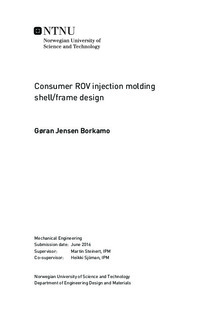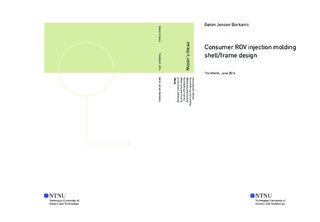| dc.contributor.advisor | Steinert, Martin | |
| dc.contributor.advisor | Sjöman, Heikki | |
| dc.contributor.author | Borkamo, Gøran Jensen | |
| dc.date.accessioned | 2019-09-11T09:12:10Z | |
| dc.date.available | 2019-09-11T09:12:10Z | |
| dc.date.created | 2016-06-14 | |
| dc.date.issued | 2016 | |
| dc.identifier | ntnudaim:15642 | |
| dc.identifier.uri | http://hdl.handle.net/11250/2615422 | |
| dc.description.abstract | This document describes the process and the outcome of a master project conducted at the Department of Engineering Design and Materials at the Norwegian University of Science and Technology in the spring of 2016. The purpose of the project was to explore the possibilities for the production of a small series of prototypes and conduct an experiment to find the most favorable method for Blueye to manufacture their prototypes in the future.
This paper starts with a brief introduction and explains the background for the thesis. Furthermore, the paper continues with Chapter 2 where the methods used to solve the task are described; design thinking and Wayfaring. Chapter 3 is dedicated to understand the current situation through knowledge gained by design thinking. Through empathizing with Blueye and an injection molding manufacturer, it was discovered that due to the expensive tools concerning injection molding, there is a need to acquire knowledge about more favorable prototype methods. This could possibly reduce the prototype s time to market and reduce cost of production of a future 0-series.
Furthermore, the theoretical background are established for the experiment and for the wayfaring model, which is an early-phase product development methodology. The method is based on a broad, short sprint approach and not following a fixed plan . An experiment on how to prototype with injection molding, 3D printing, castings with 2-component resin and milling were performed. Testing was angled experimentally, by allowing findings revealed through testing, determine the road ahead. It was quickly revealed that rapid tooling had potential in the form of small scale casting production, various molding materials was therefore tested. To take this concept further, there was performed a basic finite element analysis to document the effect of favorable geometric structures according to guidelines for molding and casting.
This task is relevant to readers interested in the following topics:
Rapid prototyping
Comparison of various prototype methods
Wayfaring model
Design of casting parts for prototyping
Finite element analysis of ABS plastic | en |
| dc.language | eng | |
| dc.publisher | NTNU | |
| dc.subject | Produktutvikling og produksjon, Produktutvikling, beregning og bearbeiding | en |
| dc.title | Consumer ROV injection molding shell/frame design | en |
| dc.type | Master thesis | en |
| dc.source.pagenumber | 105 | |
| dc.contributor.department | Norges teknisk-naturvitenskapelige universitet, Fakultet for ingeniørvitenskap,Institutt for maskinteknikk og produksjon | nb_NO |

